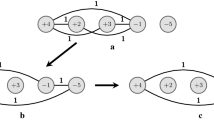Abstract
Genome Rearrangement is a field that addresses the problem of finding the minimum number of global operations that transform a given genome into another. In this work, we deal with inversion events, which occur when a segment of DNA sequence in the genome is reversed. In our model, each inversion costs the number of elements in the reversed segment. We present a new heuristic for this problem and we show that our method outperforms a previous approach. Our method uses the metaheuristic called Greedy Randomized Adaptive Search Procedure (GRASP) that has been routinely used to find solutions for combinatorial optimization problems. In essence, we implemented an iterative process in which each iteration receives a feasible solution whose neighborhood is investigated for a better solution. We use as initial solution a sequence of inversions of minimum length when each inversion costs one unit, which is a problem that already has several polynomial time algorithms. In almost every case, we were able to improve that initial solution by providing a less-costly sequence of inversions.
Access this chapter
Tax calculation will be finalised at checkout
Purchases are for personal use only
Preview
Unable to display preview. Download preview PDF.
Similar content being viewed by others
References
Aiex, R.M., Binato, S., Resende, M.G.C.: Parallel grasp with path-relinking for job shop scheduling. Parallel Computing 29, 2003 (2002)
Ajana, Y., Lefebvre, J.F., Tillier, E.R.M., El-Mabrouk, N.: Exploring the set of all minimal sequences of reversals - an application to test the replication-directed reversal hypothesis. In: Guigó, R., Gusfield, D. (eds.) WABI 2002. LNCS, vol. 2452, pp. 300–315. Springer, Heidelberg (2002)
Arruda, T.S., Dias, U., Dias, Z.: Heuristics for the sorting by length-weighted inversion problem. In: Proceedings of the International Conference on Bioinformatics, Computational Biology and Biomedical Informatics, pp. 498–507. ACM (2013)
Bäck, T.: Evolutionary algorithms in theory and practice: evolution strategies, evolutionary programming, genetic algorithms. Oxford University Press, Oxford (1996)
Bader, D.A., Moret, B.M.E., Yan, M.: A linear-time algorithm for computing inversion distance between signed permutations with an experimental study. Journal of Computational Biology 8(5), 483–491 (2001)
Bergeron, A.: A very elementary presentation of the Hannenhalli-Pevzner theory. Discrete Applied Mathematics 146, 134–145 (2005)
Blanchette, M., Kunisawa, T., Sankoff, D.: Parametric genome rearrangement. Gene 172(1), C11–C17 (1996)
Cano, R.G., Kunigami, G., Souza, C.C., Rezende, P.J.: A hybrid grasp heuristic to construct effective drawings of proportional symbol maps. Computers and Operations Research 40(5), 1435–1447 (2013)
Darling, A.E., Miklós, I., Ragan, M.A.: Dynamics of genome rearrangement in bacterial populations. PLoS Genetics 4(7), 1000128 (2008)
Feo, T., Resende, M.G.C.: Greedy randomized adaptive search procedures. Journal of Global Optimization 6(2), 109–133 (1995)
Feo, T.A., Pardalos, M.: A greedy randomized adaptive search procedure for the 2-partition problem. Operations Research (1994)
Festa, P., Resende, M.: Grasp: basic components and enhancements. Telecommunication Systems 46(3), 253–271 (2011)
Hannenhalli, S., Pevzner, P.A.: Transforming cabbage into turnip: polynomial algorithm for sorting signed permutations by reversals. Journal of the ACM 46(1), 1–27 (1999)
Laguna, M., Martí, R.: Grasp and path relinking for 2-layer straight line crossing minimization. INFORMS Journal on Computing 11, 44–52 (1999)
Lefebvre, J.F., El-Mabrouk, N., Tillier, E., Sankoff, D.: Detection and validation of single gene inversions. Bioinformatics 19, i190–i196 (2003)
Ribeiro, C.C., Uchoa, E., Werneck, R.F.: A hybrid grasp with perturbations for the steiner problem in graphs. INFORMS Journal on Computing 14, 200–202 (2001)
Sankoff, D.: Short inversions and conserved gene cluster. Bioinformatics 18(10), 1305–1308 (2002)
Sankoff, D., Lefebvre, J.F., Tillier, E., Maler, A., El-Mabrouk, N.: The distribution of inversion lengths in bacteria. In: Lagergren, J. (ed.) RECOMB-WS 2004. LNCS (LNBI), vol. 3388, pp. 97–108. Springer, Heidelberg (2005)
Swidan, F., Bender, M., Ge, D., He, S., Hu, H., Pinter, R.: Sorting by length-weighted reversals: Dealing with signs and circularity. In: Sahinalp, S.C., Muthukrishnan, S.M., Dogrusoz, U. (eds.) CPM 2004. LNCS, vol. 3109, pp. 32–46. Springer, Heidelberg (2004)
Tannier, E., Sagot, M.-F.: Sorting by reversals in subquadratic time. In: Sahinalp, S.C., Muthukrishnan, S.M., Dogrusoz, U. (eds.) CPM 2004. LNCS, vol. 3109, pp. 1–13. Springer, Heidelberg (2004)
Tesler, G.: Grimm: genome rearrangements web server. Bioinformatics 18(3), 492–493 (2002), http://bioinformatics.oxfordjournals.org/content/18/3/492.abstract
Author information
Authors and Affiliations
Editor information
Editors and Affiliations
Rights and permissions
Copyright information
© 2014 Springer International Publishing Switzerland
About this paper
Cite this paper
da Silva Arruda, T., Dias, U., Dias, Z. (2014). Heuristics for the Sorting by Length-Weighted Inversions Problem on Signed Permutations. In: Dediu, AH., Martín-Vide, C., Truthe, B. (eds) Algorithms for Computational Biology. AlCoB 2014. Lecture Notes in Computer Science(), vol 8542. Springer, Cham. https://doi.org/10.1007/978-3-319-07953-0_5
Download citation
DOI: https://doi.org/10.1007/978-3-319-07953-0_5
Publisher Name: Springer, Cham
Print ISBN: 978-3-319-07952-3
Online ISBN: 978-3-319-07953-0
eBook Packages: Computer ScienceComputer Science (R0)




